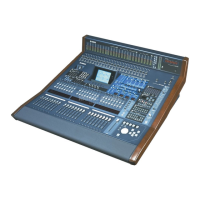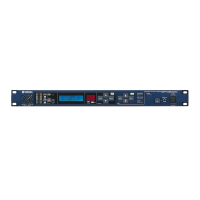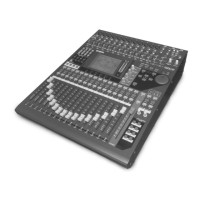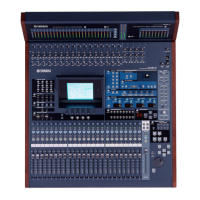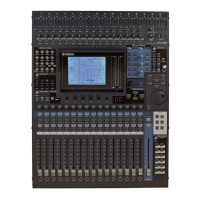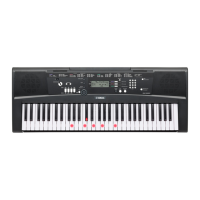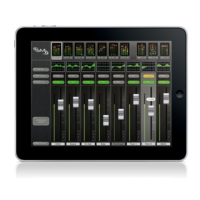1-4. Initialization
Refer to "Initializing the internal memory" for the procedures
of initializing the internal memory. (See page 181.)
1-5. Fader Calibration
Refer to "Calibration function: Calibrating faders" for the
procedures of calibrating faders. (See page 183.)
1-6.
CPU circuit board SRAM Backup Inspection
Check that "== INITIALIZE MENU ==" does not appear on
the LCD screen when the power is turned on.
2. ANALOG IN/OUT Characteristic Inspection
2-1. LS9-16: OMNI OUT 1–8
LS9-32:
OMNI OUT 1–16
Parameters: Input from INPUT (XLR) of CH1.
LS9-16: Assign CH1 to OMNI OUT 1–8.
LS9-32: Assign CH1 to OMNI OUT 1–16.
1 Gain
(LS9-16: OMNI OUT
1–8 / LS9-32: OMNI OUT 1–16)
2 Distortion
(LS9-16: OMNI OUT
1–8 / LS9-32: OMNI OUT 1–16)
3 Residual noise
(LS9-16: OMNI OUT
1–8 / LS9-32: OMNI OUT 1–16)
Parameters: Turn off STEREO.
4 LS9-16: OMNI OUT 1–8 level difference
LS9-32: OMNI OUT
1–16 level difference
Conrm the range of difference in the gain measured in item 1
above as follows.
5 Crosstalk between adjacent channels
(LS9-16: OMNI OUT
1–8 / LS9-32: OMNI OUT 1–16)
Parameters: Turn on OMNI OUT of only one odd number
channel for output, turned off OMNI OUT of
other channels. And measure the noise level of
even number channels next to the odd number
channel on both side.
Perform the same check on the even number channels.
INSPECTIONS
Input Frequency
Input Level
Prescribed Output Level Permissible Range
1 kHz +10 dBu +4 dBu +4±2 dBu
Input Frequency
Output Level Permissible Range
1 kHz +22 dBu 0.01 % or below
Permissible Range
–86 dBu or below
Input Frequency
Output Level
(Odd Channel)
Permissible Range
(Even Channel)
1 kHz +23 dBu
–57 dBu or below
Permissible Range
Within 1 dB
1. Preparation
1-1. Measuring Instruments
Use measuring instruments which can measure the inspection
items accurately with condence.
Input impedance of the measuring device should be 100 kΩ or more.
• System Two
Multi-Volt Meter
Filter (12.7 kHz, –6 dB/OCT)
Level meter
1-2. Parameters
Unless otherwise specified, the parameter settings are as
follows.
• Set the WORD CLOCK to INT 48 kHz.
• Set the "+48 V MASTER" to ON.
• Turn on only the channel being measured.
P
AN : CENTER
GAIN : MIN
FADER : NOMINAL (0 dB)
PHONES LEVEL : MAX
• 0 dBu = 0.775 Vrms
• 0 dBFS = 0 dB, full scale
• The oscillator output impedance should be 150 Ω.
• Measure the noise level with a 12.7 kHz, –6 dB/octave low
pass lter.
(For measurement, use the average values and not effective
values.)
• Correct the distortion measurement with an 80 kHz, –18
dB/octave low pass lter.
For analog output inspection, add or change parameter
settings as follows.
• For maximum output measurement, unless otherwise
specied, output 0 dB from the internal oscillator.
• Set the analog output loads as follows:
OMNI OUT
: 600 Ω
PHONES: 8 Ω
1-3. Updating the Program
If the main program is not the latest version, it is required to
update it to the latest version.
*
For the latest version, download the latest program from the
YSISS home page and save it in the USB memory device.
(1) How to check the version of the main program
Press the
[SET UP]
button and the current version will be
shown in the "MUSIC SETUP" page screen.
(2) How to write programs
For the program writing procedure, refer to the "Updating the
Firmware" in service inspection program section.
(See page 131.)
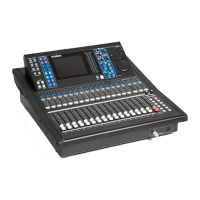
